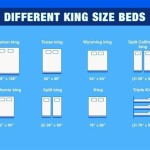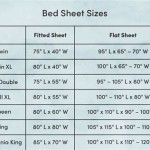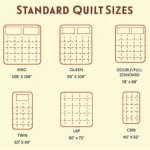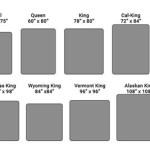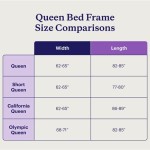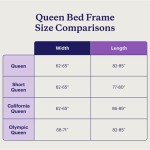What Is Queen Size Bed Measurements? A Comprehensive Guide
The queen size bed is a popular choice for many sleepers, offering a balance between space efficiency and sleeping comfort. It's larger than a full-size bed, providing more room for individuals and couples, yet smaller than a king size bed, making it a more practical option for smaller bedrooms. Understanding the exact measurements of a queen size bed, along with related factors, is crucial when planning a bedroom layout, purchasing bedding, and making informed decisions about sleeping arrangements.
This article details the standard dimensions of a queen size bed, explores variations and related considerations, and clarifies the differences between a queen size bed and other common bed sizes. Additionally, it will provide information about the space requirements for a bedroom to comfortably accommodate a queen size bed.
Standard Queen Size Bed Dimensions
The standard queen size bed measures 60 inches in width and 80 inches in length. These dimensions translate to 5 feet wide and 6 feet 8 inches long. These measurements apply to the mattress itself, and it's the most common dimension used in the bedding industry. It is important to note that these measurements refer specifically to the sleeping surface area provided by the mattress.
The dimensions of the bed frame, headboard, and footboard can vary significantly depending on the design and style. A platform bed frame might closely match the mattress dimensions, while a bed frame with a headboard and footboard will typically add several inches to both the width and length of the total bed footprint. Therefore, when determining if a queen size bed will fit in a room, it is essential to consider the overall dimensions of the bed, including the frame and any attached components.
The depth or height of a queen size mattress can also vary, generally ranging from 8 inches to 14 inches or more. This height affects the overall height of the bed, which is important for accessibility and aesthetics. Individuals with mobility issues may prefer a lower profile mattress and frame, while others may prefer a taller bed for ease of getting in and out. The height of the mattress and frame combination is a personal preference that should be considered when making a purchase.
Variations and Related Considerations
While the standard dimensions of a queen size bed are generally consistent, several variations exist to cater to specific needs and preferences. These variations mainly involve slight adjustments to the length and width of the sleeping surface.
One notable variation is the Olympic queen size bed. An Olympic queen measures 66 inches wide and 80 inches long, offering an additional 6 inches of width compared to a standard queen. This provides more sleeping space for couples or individuals who prefer more room to move around. However, bedding specifically designed for an Olympic queen may be less readily available than standard queen-sized bedding.
Another variation is the California queen size bed. While not as common as the standard or Olympic queen, the California queen is typically 60 inches wide, the same as a standard queen, but it can be longer, reaching up to 84 inches. This is designed to accommodate taller individuals. Again, finding bedding specifically for a California queen may be more challenging than for a standard queen.
Furthermore, some manufacturers may offer slight variations in their queen size mattresses, typically within a margin of one or two inches. These variations are often due to differences in manufacturing processes or design features. It is recommended to always check the exact dimensions of a mattress before purchasing bedding to ensure a proper fit.
When selecting a queen size bed, it is also important to consider the type of mattress. Common mattress types include innerspring, memory foam, latex, and hybrid mattresses. Each type offers different levels of support, comfort, and temperature regulation. The choice of mattress type is a personal preference based on individual sleeping habits and needs. Additionally, the type of mattress can influence the overall weight of the bed, which is important to consider when moving or setting up the bed.
The support system beneath the mattress, such as a box spring or platform, also plays a crucial role in the overall comfort and longevity of the bed. A proper support system ensures that the mattress is evenly supported, preventing sagging and extending its lifespan. Box springs are typically used with innerspring mattresses, while platform beds provide direct support for the mattress without the need for a box spring. The choice of support system depends on the type of mattress and personal preference.
Queen Size Bed vs. Other Bed Sizes
Understanding how a queen size bed compares to other common bed sizes is essential for making an informed decision about which size is most suitable. The most commonly compared bed sizes are twin, full (or double), king, and California king.
A twin size bed measures 38 inches wide and 75 inches long. It is the smallest standard bed size and is typically used for children or single adults in small bedrooms. A queen size bed offers significantly more sleeping space than a twin, making it a better option for adults who prefer more room to move around.
A full size bed measures 54 inches wide and 75 inches long. It is larger than a twin but smaller than a queen. A full size bed can accommodate two adults, but it can be quite cramped, especially for couples who prefer more personal space. A queen size bed provides an additional 6 inches of width and 5 inches of length compared to a full, offering a more comfortable sleeping experience for couples.
A king size bed measures 76 inches wide and 80 inches long. It is the widest standard bed size and provides ample sleeping space for couples who prefer a lot of personal space. A king size bed is 16 inches wider than a queen, making it a significantly larger bed. However, a king size bed requires a larger bedroom to accommodate its dimensions comfortably.
A California king size bed measures 72 inches wide and 84 inches long. It is narrower than a standard king but longer, making it a good option for taller individuals. A California king is 12 inches wider and 4 inches longer than a queen. Similar to a king size bed, a California king requires a larger bedroom.
The choice between a queen size bed and other bed sizes depends on several factors, including the available bedroom space, the number of sleepers, and personal preferences for sleeping space. A queen size bed is a versatile option that offers a good balance between space efficiency and sleeping comfort, making it a popular choice for many individuals and couples.
Bedroom Space Requirements for a Queen Size Bed
The dimensions of a bedroom are crucial when determining whether a queen size bed will fit comfortably. While the mattress itself measures 60 inches by 80 inches, the overall dimensions of the bed frame and accompanying furniture must also be considered. A minimum bedroom size of 10 feet by 10 feet is generally recommended for a queen size bed to allow for adequate space around the bed for movement and other furniture.
In a bedroom that is 10 feet by 10 feet, a queen size bed will occupy a significant portion of the floor space. It is essential to plan the layout of the room carefully to ensure that there is enough space to walk around the bed and accommodate other essential furniture, such as nightstands, dressers, and chairs. A well-planned layout can maximize the functionality and comfort of the bedroom.
For a more comfortable and spacious bedroom layout, a larger room size is recommended. A bedroom measuring 12 feet by 12 feet or larger provides ample space for a queen size bed, nightstands on either side, a dresser, and potentially a small seating area. This allows for greater freedom of movement and a more visually appealing and less cluttered space.
When planning the bedroom layout, it is also important to consider the placement of doors and windows. The bed should be positioned in a way that does not obstruct doorways or windows, and there should be enough space to open and close doors and drawers freely. The orientation of the bed can also affect the overall feel of the room, with some individuals preferring to position the bed facing the door for a sense of security.
Additionally, consider the height of the ceiling. While not directly related to the floor space, a low ceiling can make a room feel cramped, especially with a larger piece of furniture like a queen size bed. In rooms with low ceilings, it may be preferable to choose a lower profile bed frame and mattress to create a greater sense of space.
In summary, carefully assessing the dimensions of the bedroom and planning the layout accordingly is essential to ensure that a queen size bed fits comfortably and contributes to a functional and aesthetically pleasing living space. The minimum recommended room size is 10 feet by 10 feet, but a larger room size of 12 feet by 12 feet or more will provide a more spacious and comfortable environment.

Queen Size Bed Dimensions Compared To Other Sizes Eachnight

Queen Bed Dimensions Guide Size In Feet Inches Centimeters

Mattress Sizes Chart And Bed Dimensions Guide Amerisleep

Difference Between Full And Queen Mattresses Texas Mattress Makers

Queen Bed Size In Meters

Full Vs Queen Size Bed 2025 Mattress Nerd

Mattress Size Guide Dimensions Australia

Bed Sizes Guide Curtain Of Maine

Difference Between King And Queen Size Bed In India

Mattress Sizes Uk Guide For Perfect Bedroom Fit

